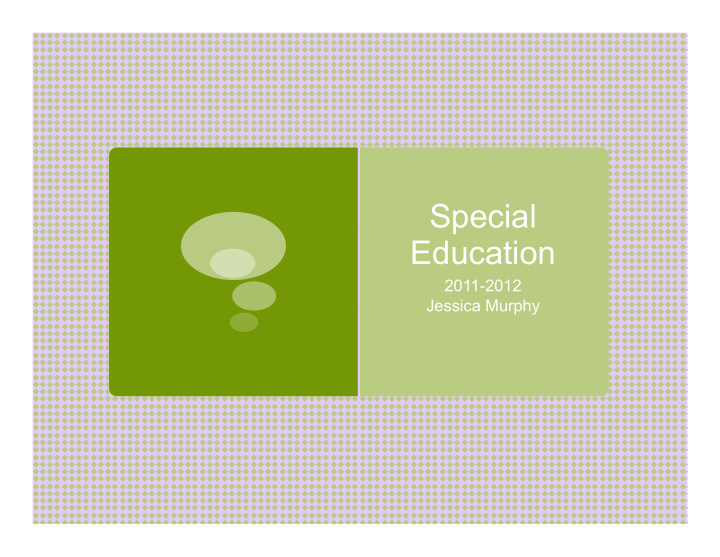



Special Education 2011-2012 Jessica Murphy
District Updates: Second year of full day preschool program Second year of Intensive Math classes at CMS First year of Intensive English and Intensive Math classes at both Peabody and Sanborn Buildings Continuing to build transition services and opportunities for students 18-22 Decrease in unilateral placements (parents placing their student and seeking district funding)
Special Education to Date: Concord Public Schools Total enrollment at Preschool: 48 Students on IEPs in Pre-K: Itinerant Students~ 5 In district~ 23 OOD~ 2 Total enrollment CPS: 2005 Students on IEPs K-5: In district~ 338 OOD~ 10 Students on IEPs 6-8: In district~ 118 OOD~ 25 Data as of 4/5/12
Special Education to Date: Concord Carlisle Regional School District Total enrollment~ 1234 Students on IEPs: In district~ 180 OOD~ 38 Number of students ages 19-22 in special education~ 19 Data as of 4/5/12
Changes in Special Education- Nationally ASD Developmental Delays Over the last 12 years, the Prevalence of ASD- Autism Spectrum DDs has increased 17.1% Disorders that’s about 1.8 million more children with DDs in 2006–2008 compared to a decade CDC numbers now showing that earlier; 1 in 88 children in the United Prevalence of autism increased 289.5%; States diagnosed with autism – Prevalence of ADHD increased 33.0%; Nearly doubling the prevalence and, since the CDC began tracking Prevalence of hearing loss decreased these numbers 30.9%. Based on CDC study: "Trends in the Prevalence of Developmental Disabilities in U.S. Children, 1997–2008.” http://www.cdc.gov/Features/ dsDev_Disabilities/
Longitudinal Study – Centers for Disease Control and Prevention Trends in the Prevalence of Developmental Disabilities in US Children, 1997–2008
Conclusions: Developmental disabilities are common and were reported in ∼ 1 in 6 children in the United States in 2006–2008. The number of children with select developmental disabilities (autism, attention deficit hyperactivity disorder, and other developmental delays) has increased, requiring more health and education services. Additional study of the influence of risk-factor shifts, changes in acceptance, and benefits of early services is needed. http://pediatrics.aappublications.org/content/early/2011/05/19/peds. 2010-2989.abstract
Impact on Concord Public Schools Disabilities seen by the preschool team 2011-2012 • Prenatal stroke • Cleft lip and palate • Chromosomal Abnormalities • Ehlers-Danlos Syndrome • Selective mutism • Brain injuries in utero • Cerebral Palsy • Angelman Syndrome • Severe apraxia of speech • PDD-NOS (Autism Spectrum Disorder) • Birth injuries • Premature births • Higher order multiples (Twins, Triplets, Quadruplets) • Hearing loss • Head injuries • Compromised vision • Non-ambulatory children • ADHD/Anxiety/Non-verbal learning needs
What we are doing… • Maximizing use of related services • Using technology • Working with the elementary teams on transition to K • Consultation with outside agencies
http://ncld.org/ at-school/ general-topics/ assistive- technology/ assistive- technology- making-good- decisions
Mo Moving Forward: � Nee eed to continue e to prepare e for medically fr fragile e and devel elopmen entally del elayed studen ents � � OOD OOD programming costs rise e due e to � the e inten ensity of f services nee eeded. � Continue e to focus on imp mplem emen entation of f resea earch based instruction � Continue e to increa ease e studen ent en engagem emen ent of f studen ents with disabilities � Continue e to devel elop transition programming for studen ents 18- 8-22 22 �
Recommend
More recommend